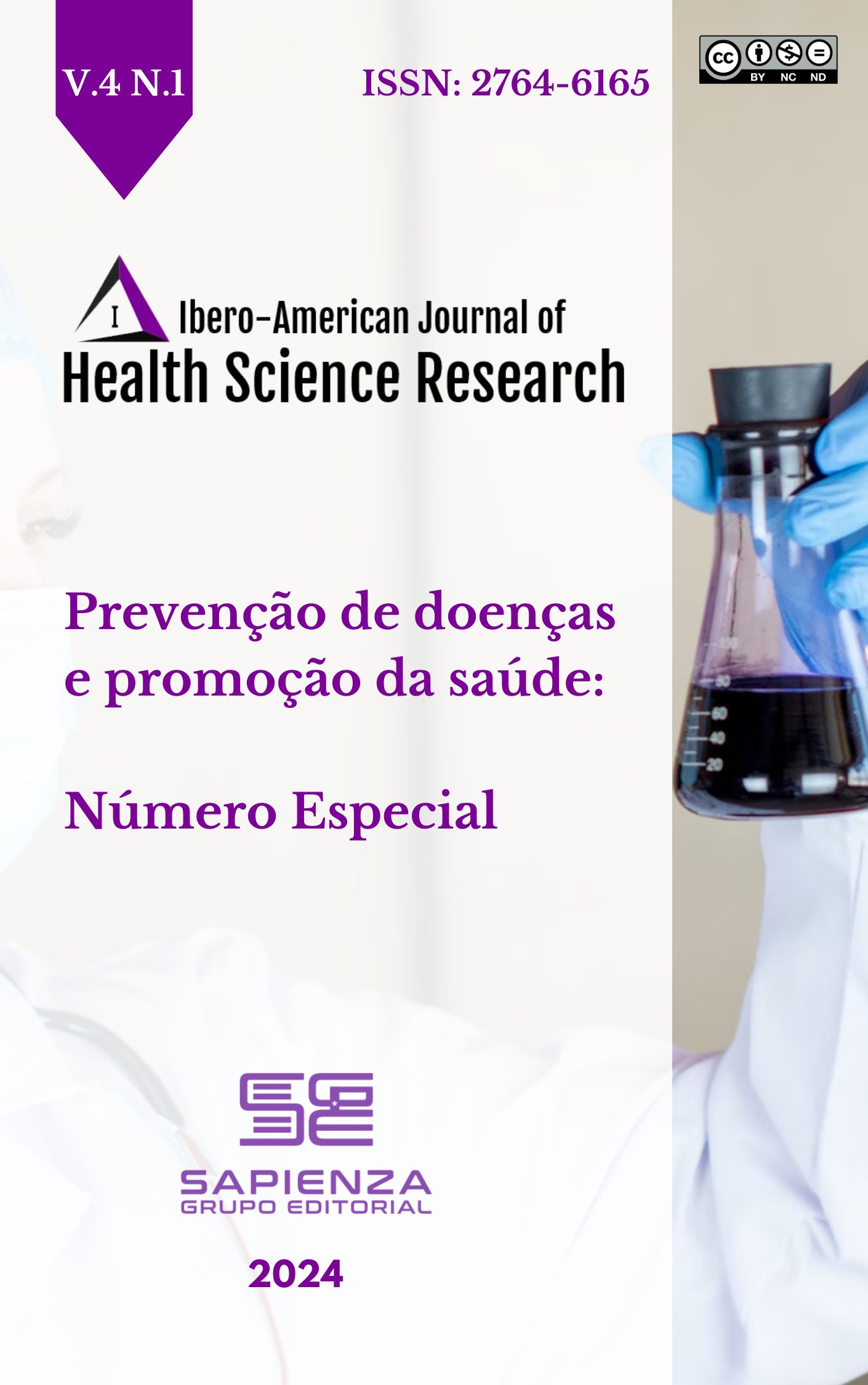Knee extension strength on gait speed in the elderly
DOI:
https://doi.org/10.56183/iberojhr.v4is.694Palavras-chave:
walking speed; muscle strength; aged; quadriceps muscle, lower extremityResumo
Background: Aging is a universal process, associated with biological modifications that cause alterations in the gait pattern, decreased walking speed, and loss of muscle strength, which decreases 1 and 2% annually in the elderly. Thus, as years go by, the elderly are associated with the loss of functionality. Gait speed is considered an indicator of mobility and functionality. In addition, it is used in the evaluation of the physical performance of the elderly. Objective: To determine the relationship of knee extension strength in the gait speed of the elderly. Methods: This research was of an observational, quantitative and cross-sectional type, with the inclusion of 25 older adults, between the ages of 65 and 90 years. The participants were evaluated for isometric knee extension strength through manual dynamometry and gait speed with the 10 Meters walk test. Results: It is verified that the right (r=0.559) and left (r=0.449) knee extension force is correlated with gait speed, obtaining a value p<0.05. It is also observed that muscle strength and gait speed decrease at advanced ages. Conclusions: Knee extension muscle strength is related to gait speed in the elderly.
Referências
Abdul, K., Seah, WT, Lau, LK, Pang, BW, Ng, DH, Tan, QL, Chen, KK, Mallya Ullal, J., Ng, TP, & Wee, SL (2021). Fast gait spatiotemporal parameters in adults and association with muscle strength - The Yishun study. Gait & posture, 85, 217–223. https://doi.org/10.1016/j.gaitpost.2021.01.001
Al, M., Párraga-Montilla, J., Lozano-Aguilera, E., López-García, S., & Moral-García, J. (2022). Strength, walking speed and reaction time in active older adults. International Journal of Medicine and Physical Activity and Sports Sciences, 22(85), 153–167. https://doi.org/10.15366/rimcafd2022.85.010
Álvarez, L., Reyes, A., Arteaga, C., Fonseca, D, Sierra Nieto, Víctor H, & Ruiz-López, María Dolores. (2020). Comprehensive geriatric assessment in a marginal community in Ecuador. Hospital Nutrition, 37(5), 926-932. https://dx.doi.org/10.20960/nh.03040
Beijersbergen, CM, Granacher, U., Vandervoort, AA, DeVita, P., & Hortobágyi, T. (2013). The biomechanical mechanism of how strength and power training improves walking speed in older adults remains unknown. Aging research reviews, 12(2), 618–627. https://doi.org/10.1016/j.arr.2013.03.001
Concha, CY, Vargas, VR, & Celis, M. (2020). Morphophysiological changes and risk of falls in older adults: a review of the literature. Salud Uninorte Magazine, 36(2), 450–470.https://doi.org/10.14482/SUN.36.2.618.97
Dommershuijsen, J., Ragunathan, J., Ruiter, R., Groothof, D., Mattace-Raso, FUS, Ikram, MA, & Polinder-Bos, HA (2022). Gait speed reference values in community-dwelling older adults - Cross-sectional analysis from the Rotterdam Study. Experimental gerontology, 158, 111646. https://doi.org/10.1016/j.exger.2021.111646
Echeverría, A., Astorga, C., Fernández, C., Salgado, M., & Villalobos Dintrans, P. (2022). Functionality and older people: where are we and where to go? Pan American journal of public health, 46, e34. https://doi.org/10.26633/RPSP.2022.34
Falcones, M., Vásquez, M., Solórzano, J., & Esmeraldas, E. (2019). The aging of the elderly and its main characteristics. Recimundo, 3(1), 58–74. https://doi.org/10.26820/RECIMUNDO/3.(1).ENERO.2019.58-74
Fukuchi, CA, Fukuchi, RK, & Duarte, M. (2019). Effects of walking speed on gait biomechanics in healthy participants: a systematic review and meta-analysis. Systematic reviews, 8(1), 153. https://doi.org/10.1186/s13643-019-1063-z
Grootswagers, P., Vaes, AMM, Hangelbroek, R., Tieland, M., van Loon, LJC, & de Groot, LCPGM (2022). Relative Validity and Reliability of Isometric Lower Extremity Strength Assessment in Older Adults by Using a Handheld Dynamometer. Sports health, 14(6), 899–905. https://doi.org/10.1177/19417381211063847
Harris, M.O., Benson, K., Leasure, E., Adams, B., & McIntosh, V. (2018). The Influence of Upper and Lower Extremity Strength on Performance-Based Sarcopenia Assessment Tests. Journal of Functional Morphology and Kinesiology, 3(4). 53 https://doi.org/10.3390/JFMK3040053
Herrera, D., Soriano, A., Gallardo. R., & Toro, C. (2020) Prevalence of frailty syndrome and associated factors in older adults. Rev Cubana Med Gen Integr, ;36(2), 1-17. Available at: https://www.medigraphic.com/cgi-bin/new/resumen.cgi?IDARTICULO=101606
Huang, W.Y., & Wu, C.E. (2022). Interventions to Improve Body Composition, Upper and Lower Extremity Muscle Strength, and Balance Ability of Older Female Adults: An Intervention Study. International journal of environmental research and public health, 19(8), 4765. https://doi.org/10.3390/ijerph19084765
Inoue, W., Ikezoe, T., Tsuboyama, T., Sato, I., Malinowska, K.B., Kawaguchi, T., Tabara, Y., Nakayama, T., Matsuda, F., & Ichihashi, N. ( 2017). Are there different factors affecting walking speed and gait cycle variability between men and women in community-dwelling older adults?. Aging clinical and experimental research, 29(2), 215–221. https://doi.org/10.1007/s40520-016-0568-8
Jiang, G., & Wu, X. (2022). Slower maximal walking speed is associated with poorer global cognitive function among older adults residing in China. Peer J, 10, e13809. https://doi.org/10.7717/peerj.13809
Jung, H., Jang, Y., Lee, K., Yu, S., Hwang, K., Jeon, C., Lee, S., & Lee, E. (2018). Usual gait speed is associated with frailty status, institutionalization, and mortality in community-dwelling rural older adults: a longitudinal analysis of the Aging Study of Pyeongchang Rural Area. Clinical interventions in aging, 13, 1079–1089. https://doi.org/10.2147/CIA.S166863
Kawai, H., Obuchi, S., Watanabe, Y., Hirano, H., Fujiwara, Y., Ihara, K., Kim, H., Kobayashi, Y., Mochimaru, M., Tsushima, E., & Nakamura, K. (2020). Association between Daily Living Walking Speed and Walking Speed in Laboratory Settings in Healthy Older Adults. International journal of environmental research and public health, 17(8), 2707. https://doi.org/10.3390/ijerph17082707
Manterola, C., Quiroz, G., Salazar, P., & García, N. (2019). Methodology of the types and study designs most frequently used in clinical research. Las Condes Clinical Medical Journal, 30(1), 36–49. https://doi.org/10.1016/J.RMCLC.2018.11.005
Muehlbauer, T., Granacher, U., Borde, R., & Hortobágyi, T. (2018). Non-Discriminant Relationships between Leg Muscle Strength, Mass and Gait Performance in Healthy Young and Old Adults. Gerontology, 64(1), 11–18. https://doi.org/10.1159/000480150
Oyarzun, F. (2020). Mobilization and walking disorders in older people: Approach from primary health care (PHC). Revista Chilena De Medicina Familiar, 14(1), 6. Available at: https://www.revistachilenademedicinafamiliar.cl/index.php/sochimef/article/view/367
Peters, D.M., Fritz, S.L., & Krotish, D.E. (2013). Assessing the reliability and validity of a shorter walk test compared with the 10-Meter Walk Test for measurements of gait speed in healthy, older adults. Journal of Geriatric Physical Therapy, 36(1), 24–30. https://doi.org/10.1519/JPT.0B013E318248E20D
Pisciottano, MVC, Pinto, SS, Szejnfeld, VL, & Castro, CHDM (2014). The relationship between lean mass, muscle strength and physical ability in independent healthy elderly women from the community. Journal of Nutrition, Health and Aging, 18(5), 554–558. https://doi.org/10.1007/S12603-013-0414-Z/METRICS
Pradeep, D., Toosizadeh, N., Mohler, J., Ehsani, H., Mannier, C., & Laksari, K. (2020). Sensor-based characterization of daily walking: a new paradigm in pre-frailty/frailty assessment. BMC geriatrics, 20(1), 164. https://doi.org/10.1186/s12877-020-01572-1
Quintero, M., Herazo, B., Cobo, E., & Sandoval, C. (2021). Functional physical condition of older adults in two Colombian cities. Health Sciences Magazine, 19(3), 1. https://doi.org/10.12804/REVISTAS.UROSARIO.EDU.CO/REVSALUD/A.10575
Sgaravatti, A., Santos, D., Bermúdez, G., Barboza, A., Sgaravatti, A., Santos, D., Bermúdez, G., & Barboza, A. (2018). Gait speed of the functionally healthy older adult. Annals of the Faculty of Medicine, 5(2), 93–101.https://doi.org/10.25184/ANFAMED2018V5N2A8
Stotz, A., Hamacher, D., Zech, A. (2023). Relationship between Muscle Strength and Gait Parameters in Healthy Older Women and Men. Int J Environ Res Public Health. ;20(7), 5362. https://doi.org/10.3390/ijerph20075362
Subirana, S., & Martínez, M. (2020). Assessment of gait in the elderly. FMC. Continuing Medical Education in Primary Care, 27(1), 4–10. https://doi.org/10.1016/J.FMC.2019.05.013
Takayanagi, N., Sudo, M., Yamashiro, Y., Lee, S., Kobayashi, Y., Niki, Y., & Shimada, H. (2019). Relationship between Daily and In-laboratory Gait Speed among Healthy Community-dwelling Older Adults. Scientific Reports, 9(1), 1–6. https://doi.org/10.1038/s41598-019-39695-0
Umegaki, H., Suzuki, Y., Komiya, H., Watanabe, K., Nagae, M., Yamada, Y., & Kuzuya, M. (2022). Association between gait speed and errors on the Clock Drawing Test in older adults with mild cognitive impairment. Scientific reports, 12(1), 9929. https://doi.org/10.1038/s41598-022-14084-2
Wu, T., & Zhao, Y. (2021). Associations between functional fitness and walking speed in older adults. Geriatric nursing (New York, NY), 42(2), 540–543. https://doi.org/10.1016/j.gerinurse.2020.10.003
Downloads
Publicado
Como Citar
Edição
Seção
Licença
Copyright (c) 2024 Richard Ismael Villacís Villacís, Gerardo Fernando Fernández Soto, Milton Alejandro Pacheco Guzmán, Franklin Hernán Cashabamba Padilla, María Alexandra Vaca Sánchez

Este trabalho está licenciado sob uma licença Creative Commons Attribution-NonCommercial-NoDerivatives 4.0 International License.



